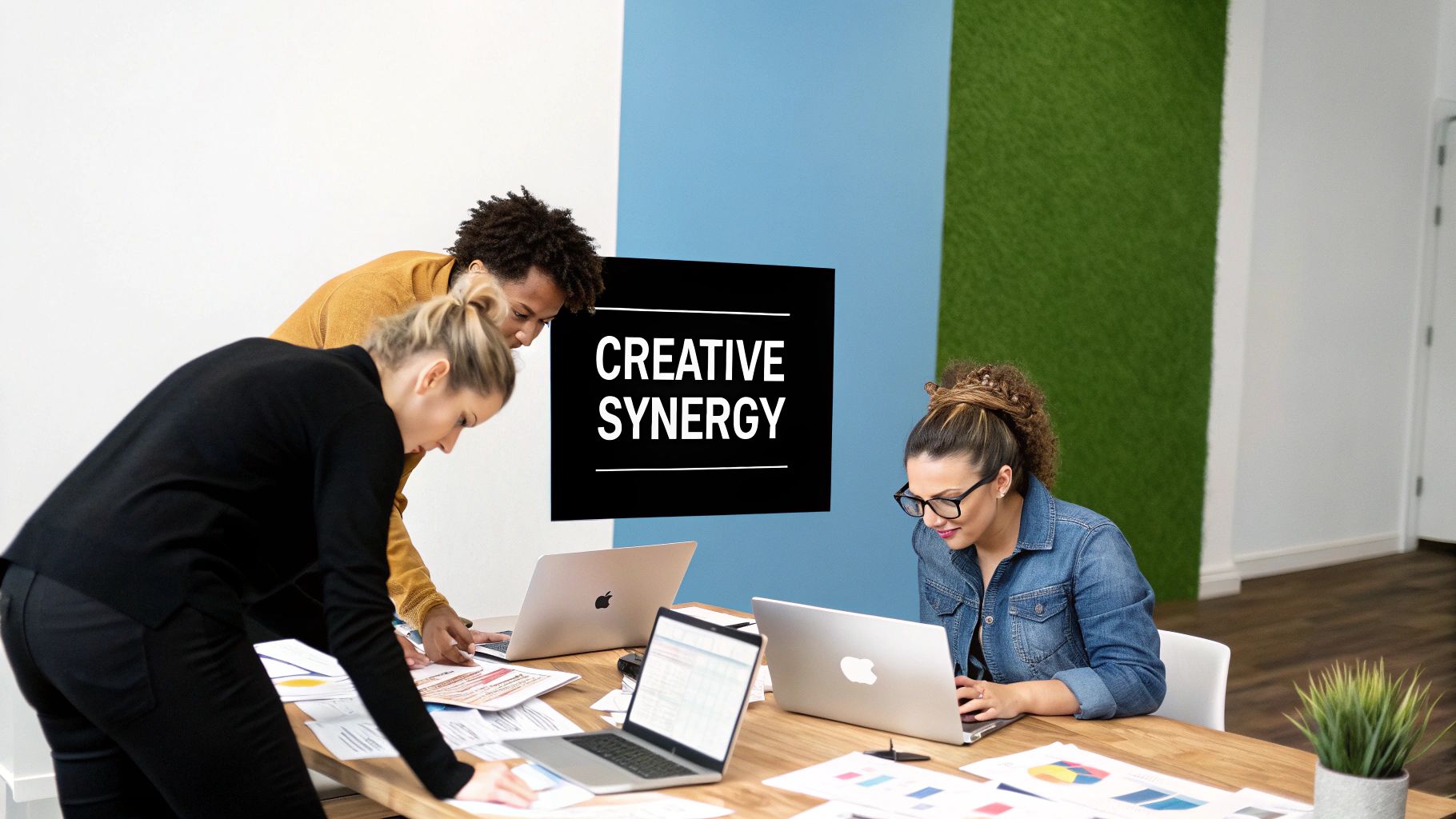The Creative Project Paradox: Structure Meets Inspiration

Creative work thrives on inspiration and freedom. However, practicalities like deadlines and deliverables exist. This presents a challenge: how do we structure something inherently fluid without stifling its creative essence? This is the core tension within creative project management.
Imagine a painter with complete freedom versus one with a brief and a deadline. Both offer creative opportunities, but the latter requires project management. Understanding the nuances of creative project direction is key.
This isn't about forcing creatives into rigid project management molds. It's about building a supportive framework that fosters collaboration and enhances artistic freedom. Think of scaffolding: it supports construction, then disappears when the masterpiece is finished.
This framework should be adaptable, acknowledging that creative projects evolve organically. The balance lies between planned deliverables and room for spontaneous inspiration.
Successful creative project management recognizes that the creative process is not linear. It's a dance between exploration and execution, often requiring an iterative approach with revisions as the project develops.
Communication is also vital. Regular check-ins, constructive feedback, and clear expectations keep everyone aligned. This acknowledges the complexity of creative projects, where the final product often emerges through discovery. The distinct nature of creative projects necessitates specialized project management approaches to balance creativity with structured delivery. Unlike traditional task-based methods, creative project management coordinates dynamic workflows from concept to completion while maintaining high quality. Key to this are clear constraints that guide creativity without hindering innovation. Explore this topic further here.
Navigating the Creative Workflow
Effective creative project management requires understanding its unique rhythm. This involves breaking the project into distinct phases, each with objectives and deliverables.
- Conceptualization: This initial phase focuses on brainstorming, ideation, and defining the overall vision. It's a time of exploration and experimentation.
- Development: Initial concepts take shape. Designers and other creatives translate the vision into tangible outputs, often involving prototyping and drafting.
- Production: The actual creation happens here. Approved designs are brought to life, copy is finalized, and the project moves towards completion.
- Revision & Feedback: This stage allows for adjustments and improvements based on stakeholder feedback, refining the work and ensuring alignment with the vision.
- Delivery & Launch: The completed project is presented to the client or audience, culminating all the creative work and effort.
By understanding these phases, project managers can anticipate the creative team's needs and provide support and resources. This structured approach ensures a productive creative process while maintaining flexibility and freedom. The goal is an environment where creativity flourishes, leading to exceptional results.
Building Creative Scaffolding: Frameworks That Liberate
The most innovative creative teams don't thrive on chaos. Instead, they use structured frameworks designed to enhance, not restrict, their creative freedom. These frameworks act as scaffolding, offering support and direction without stifling the organic flow of creative development.
Milestone Mapping for Creative Rhythms
Think of milestone mapping as a roadmap for your creative journey. Instead of rigid deadlines, milestones mark key checkpoints in the creative process. This allows flexibility within each stage while ensuring the project moves toward completion.
For example, a milestone could be completing a prototype, approving a script, or finalizing a design concept. These milestones respect the natural rhythm of creative development, acknowledging that inspiration doesn't always follow a strict schedule.
Documentation That Serves, Not Stifles
Documentation often gets a bad rap in creative fields, seen as unnecessary bureaucracy. However, effective documentation can actually boost the creative process.
Instead of burdensome paperwork, focus on creating living documents that capture ideas, track decisions, and improve communication. This might involve using visual collaboration tools like Miro, shared online whiteboards, or even simple shared documents that allow for real-time feedback and iterative development. This approach keeps everyone aligned while preserving creative energy.
Adaptive Scope Management for Creative Evolution
Creative projects often evolve organically, with new ideas and directions emerging as the work progresses. Adaptive scope management accommodates this natural evolution while preventing scope creep that can derail timelines and budgets.
It involves establishing clear parameters at the outset, then allowing for flexibility within those boundaries. For example, if a new concept emerges during the design phase, evaluate its impact on the overall project. Make informed decisions about whether to incorporate it, modify it, or postpone it to a later phase. This flexibility is crucial for maximizing creative potential while maintaining project viability.
However, finding the right balance is challenging. Even with advancements in project management, 2024 research showed only 34% of organizations consistently complete projects on budget and on time. Just 36% fully realize the intended project benefits. This highlights the ongoing challenge of effectively managing projects, particularly in creative fields. Find more detailed statistics here.
Empowering Creative Directors Through Frameworks
Successful creative directors understand the power of frameworks. They create environments where project management becomes an invisible support system, empowering creative teams to thrive.
This involves setting clear expectations, providing necessary resources, and fostering open communication. By establishing a supportive framework, creative directors can unlock their team’s full potential and deliver exceptional results. This translates to greater efficiency, improved collaboration, and a higher likelihood of project success, even amidst complex creative challenges.
The Creative Tech Stack: Tools That Amplify, Not Complicate

The right tech stack is key for creative project management. Instead of being a source of frustration, it can become a powerful engine for innovation. This isn't about adopting every new tool available, but about strategically choosing platforms that enhance your team's creative flow. Think of it like an artist selecting the perfect brushes and paints – the tools should amplify their vision, not complicate the process.
Essential Components of a Creative Tech Stack
Just as an artist needs a variety of tools, creative teams require diverse platforms to support their workflows. A well-rounded tech stack might include these essential elements:
- Visual Collaboration Platforms: These tools are like digital whiteboards, facilitating brainstorming, mind mapping, and real-time collaboration on visual assets. Ideas can be sketched, shared, and refined collaboratively.
- Asset Management Systems: Managing numerous files, revisions, and feedback can be overwhelming. Asset management systems provide a central hub for storing, organizing, and accessing all project materials, ensuring the latest versions are readily available.
- Feedback Tools: Feedback is crucial in the creative process. These tools streamline providing and receiving critiques, allowing for clear annotations, version control, and consolidated feedback loops.
Choosing the Right Tools for Your Team
Building a creative tech stack isn't one-size-fits-all. The best combination of tools depends on team size, project scope, budget, and the specific creative discipline. A video production team will have different needs than a graphic design studio, for example.
However, some key considerations apply across all creative fields:
- Ease of Use: Tools should be intuitive and easy to learn, minimizing the learning curve and encouraging adoption. Complex interfaces can hinder creativity.
- Integration Capabilities: Seamless integration with other tools in your tech stack is essential for smooth workflows. Your project management software should integrate with your asset management system and feedback tools.
- Customization Options: The ability to tailor tools to your team’s specific needs is crucial. This might involve customizing workflows, templates, or access permissions.
Choosing the right tools helps avoid tool overload, where too many platforms create complexity. The goal is a seamless ecosystem that supports your team’s creative rhythm. This growing need for effective project management is reflected in the market’s expansion. In 2023, the market was valued at $7.36 billion and is projected to reach $15.06 billion by 2032, a CAGR of 18.48%. Learn more about this growth at ProofHub.
To help illustrate the variety of options and their strengths, let's look at a comparison of a few popular platforms:
Creative Project Management Software Comparison: A comparison of leading project management tools specifically evaluated for creative workflows
| Software | Best For | Visual Collaboration | Asset Management | Feedback Tools | Integration Capabilities | Price Range |
|---|---|---|---|---|---|---|
| Asana | Marketing & Creative Teams | Kanban boards, timelines | Basic file sharing | Commenting, proofing | Wide range of integrations | Free – $24.99/user/month |
| Monday.com | Visual project management | Customizable boards, dashboards | File storage, versioning | Annotations, visual feedback | Extensive integrations | Free – $16/user/month |
| Adobe Workfront | Enterprise-level creative teams | Gantt charts, collaborative workspaces | Robust digital asset management | Review and approval workflows | Adobe Creative Cloud integration | Contact for pricing |
This table highlights key differences and similarities between popular project management platforms catering to creative needs. Consider factors like visual collaboration features, asset management capabilities, and integration options when making your choice.
Tailoring Your Approach to Different Project Phases
Creative teams need to adapt their tech stack to different project phases. During the concept development stage, visual collaboration platforms are key. As the project moves into feedback cycles, dedicated feedback tools become essential. Finally, during final delivery, asset management systems ensure a smooth handoff.
By customizing their technology approach to different phases, creative teams maximize the value of their tech stack and minimize tool overload. This fosters a balance between structure and spontaneity, leading to better creative outcomes and more efficient project delivery.
The Creative Constraint Advantage: Boundaries That Inspire

Constraints often carry a negative connotation, particularly in creative fields. But limitations in budget, time, and scope can actually ignite creative problem-solving. This section explores how project management for creatives can use constraints to drive innovation. Think of a sculptor and a block of marble: the material's inherent limitations shape and inspire the final piece.
Framing Constraints as Creative Catalysts
Imagine a photographer tasked with capturing the soul of a city in just one photograph. This limitation forces them to distill their vision, make decisive choices about composition and perspective, and discover unique viewpoints—ultimately elevating their work. Similarly, budget restrictions can encourage designers to develop ingenious solutions with readily available resources or explore different production methods.
This is where effective project management for creatives comes into play. By reframing constraints as opportunities instead of roadblocks, project managers empower creative teams to embrace limitations as sources of inspiration. This shift in perspective can unlock unexpected creative breakthroughs.
Establishing Parameters That Focus Energy
Constraints provide essential focus. Just as a writer thrives within a word count, a design team benefits from clearly defined parameters. These boundaries channel creative energy, preventing projects from becoming unfocused or straying from core objectives.
A tight deadline, for instance, can cultivate a sense of urgency and concentration, motivating the team to prioritize critical tasks and streamline decision-making. This focused effort often results in a more polished and impactful final product.
Negotiating Project Boundaries
Balancing business needs with artistic vision is crucial in project management for creatives. This involves negotiating project boundaries that respect both practical considerations and the creative spirit. It's a delicate balance between feasibility and inspiration.
Open communication between stakeholders and the creative team is essential. Project managers serve as mediators, ensuring everyone understands the reasons behind any constraints and finding common ground that respects both artistic aspirations and budgetary realities. This collaborative approach fosters mutual understanding and contributes to a shared project vision.
Addressing Creative Ambition vs. Practical Limitations
Creative ambitions can sometimes conflict with practical limitations. Project management for creatives provides a framework for navigating these inevitable conflicts constructively. This could involve revisiting the project scope, brainstorming alternative approaches, or adjusting timelines to accommodate unforeseen challenges.
Educating stakeholders about the creative process can also build understanding of the unique value generated by the tension between ambition and constraints. This can lead to more realistic expectations and greater appreciation for the creative team’s efforts.
The Power of Productive Tension
The most innovative creative work often emerges from the productive tension between vision and constraints. This tension compels creatives to think outside the box, experiment with new methods, and push the boundaries of their craft. It’s within this space of creative constraint that true innovation flourishes. By understanding and harnessing this dynamic, project managers can help creative teams realize their full potential and deliver truly exceptional work, benefiting both the team and the stakeholders invested in the project.
The Language of Creative Collaboration: Communication That Works
Communication in creative projects goes beyond simple checklists. It's about conveying a vision, navigating the subjective nature of creative work, and ensuring everyone is on the same page. This requires project management for creatives to prioritize clear communication strategies.
Building a Shared Language: Translating Vision Into Reality
Effective project management for creative teams depends on turning abstract ideas into concrete actions. This begins with a shared vocabulary. For example, if a client asks for a "modern" design, what does "modern" actually mean to them? Defining these terms upfront avoids miscommunication and keeps the team focused on a shared goal.
This shared language also includes visual references, mood boards, and style guides. These tools create a visual shorthand that everyone can grasp, regardless of their individual creative background.
The Art of Constructive Critique: Feedback That Fuels Growth
Feedback is essential for any creative project. However, poorly delivered critiques can damage morale and hinder creativity. Project management for creatives requires structuring feedback sessions to encourage growth.
Here are some tips for productive critique sessions:
- Focus on the work, not the person: Center feedback around project objectives and avoid personal criticism.
- Be specific and actionable: Instead of vague comments, explain the issue and offer specific suggestions for improvement.
- Balance positive and negative feedback: Highlight what's working well in addition to areas for improvement.
This approach transforms critiques into collaborative learning experiences, building a culture of open communication.
Transforming Vague Feedback Into Actionable Steps
Vague feedback like "Make it pop" can be frustrating. Effective project management for creatives requires clarifying this ambiguity into actionable steps.
This involves asking questions to understand the feedback's meaning. Does "make it pop" mean brighter colors, bolder fonts, or added animation? Once clarified, translate the feedback into specific tasks for the creative team.
Documentation for Visual Thinkers: Respecting the Creative Process
Traditional documentation can be difficult for visual thinkers. Project management for creatives should adapt documentation to fit the creative process.
Consider using visual tools like Miro or shared online mood boards to document decisions and track progress. This approach keeps everyone aligned while respecting the visual nature of creative work.
Client Communication: Protecting Creative Integrity While Ensuring Alignment
Client communication is a delicate balancing act. It involves maintaining the creative team's artistic vision while meeting the client's goals.
This requires setting clear expectations from the start, using regular communication channels, and presenting work in a way that showcases the creative process. This transparency builds trust and fosters productive conversations about feedback and revisions. It also helps manage stakeholder expectations which can sometimes clash with creative vision.
Meeting Frameworks for Deep Work: Balancing Structure and Flow
Creative work often needs focused "flow states." Project management for creatives needs to balance this with necessary team coordination.
Consider using asynchronous communication, scheduling dedicated "maker time," or using flexible meeting structures. This allows focused creative development within a structured project environment, recognizing that creativity thrives with a balance of structure and flexibility.
By using these communication strategies, project management for creatives builds a more collaborative and efficient creative process. This approach ensures the final product not only meets project objectives but also fulfills the creative team's artistic vision, leading to exceptional results.
Beyond Deliverables: Measuring Creative Project Success

Evaluating creative work isn't easy. How do you measure success when the output isn't always about numbers? Project management for creatives needs to find ways to quantify impact while still acknowledging the artistic nature of the work. It's a balancing act between artistic merit and tangible results. This section explores how to effectively measure creative project success, using frameworks that consider both artistic value and business impact.
Establishing Meaningful KPIs for Creative Projects
Traditional key performance indicators (KPIs), such as sales or website traffic, don't always tell the whole story of creative work. A beautifully designed website might not lead to immediate sales, but it can significantly enhance brand perception and foster long-term customer loyalty.
Project management for creatives requires defining KPIs specific to each project's goals. These might include metrics like brand awareness, social media engagement, or customer satisfaction. These KPIs provide a more complete picture of a project's true impact.
Gathering and Implementing Qualitative Feedback
While numbers are important, qualitative feedback provides rich insights into a project's resonance. Gathering feedback from clients, target audiences, and even internal stakeholders is essential.
Surveys, interviews, and focus groups are valuable tools for gathering feedback. This information provides a nuanced understanding of how the project connected with its audience. Using that feedback demonstrates a commitment to continuous improvement, leading to better future projects.
Creative Retrospectives: Fueling Growth, Not Blame
Post-project reviews are vital, but creative retrospectives require a unique approach. The focus should be on learning and growth, not assigning blame.
Create a safe space for team members to openly discuss challenges, successes, and areas for improvement. This encourages honest reflection and helps identify how project management for creatives can evolve, leading to stronger teams and better workflows.
Communicating Creative Value to Stakeholders
Different stakeholders have different priorities. Some may prioritize financial returns, while others focus on brand building or artistic excellence. Project management for creatives requires clear communication that resonates with each group.
Tailor your message to address their specific concerns. For example, demonstrating how creative work contributes to brand awareness or enhances customer experience is often more effective than solely showcasing artistic merit.
Defining and Building Success
Success in creative project management is about defining what truly matters. It's about establishing evaluation processes that build creative confidence, not stifle it. A music composer's success isn't just album sales, but also the emotional connection their music creates.
This mindset encourages risk-taking, pushing boundaries, and delivering exceptional creative work. It cultivates a culture of innovation and celebrates the multifaceted value of creativity.
To understand how to best measure the success of your creative projects, the table below offers a framework of metrics, their usage, and limitations.
Creative Project Success Metrics
| Metric Category | Example Metrics | When to Use | How to Measure | Limitations |
|---|---|---|---|---|
| Impact | Brand awareness, customer engagement, social media shares | When assessing how the project resonated with the target audience | Social listening tools, surveys, website analytics | Can be difficult to directly link to ROI |
| Process | Time to completion, budget adherence, resource allocation | For evaluating project efficiency and team performance | Project management software, time tracking tools | Doesn't account for unexpected creative challenges |
| Quality | Client satisfaction, peer reviews, industry awards | To evaluate artistic merit and craftsmanship | Client feedback forms, expert reviews, award submissions | Can be subjective and influenced by personal taste |
| Business Outcomes | Sales conversions, lead generation, website traffic | To demonstrate the tangible business impact of the project | Sales dashboards, marketing analytics platforms | May not fully capture the long-term benefits of creative work |
This table helps illustrate the variety of ways to measure success in creative projects. While business outcomes are important, the overall impact, quality, and efficiency of the creative process are essential elements in a successful project.
Creative Agility: Adapting Methodologies That Actually Work
Traditional agile methodologies, designed for software development, often clash with the fluid nature of creative projects. Imagine forcing a jazz improvisation into a rigid, pre-determined structure. It simply doesn't work. This section explores how successful creative teams adapt agile principles to support artistic workflows, creating a harmonious blend of structure and spontaneity. It's about building a flexible framework that adapts to the unpredictable currents of the creative process, not one that constrains it.
Reimagining Sprints and Standups for Creative Rhythm
Sprints, those short, focused work periods, can be adapted for creative projects. Instead of fixed features, creative sprints can focus on exploring concepts, developing prototypes, or refining a particular element. Think of it as setting a short-term creative goal, like completing a series of character sketches or composing a musical theme. This allows for focused bursts of creative energy within a structured timeframe.
Standups, brief daily team meetings, can also be tailored for creative teams. Instead of simply reporting on completed tasks, standups can become a platform for sharing inspiration, discussing roadblocks, and aligning creative direction. This quick exchange of ideas can spark new possibilities and maintain team momentum.
Review Cycles That Enhance, Not Interrupt, Flow States
Feedback is essential for creative projects, but constant interruptions can disrupt the delicate flow state crucial for deep creative work. Imagine a writer deep in concentration suddenly pulled away for a feedback session. The creative thread is broken, making it difficult to regain momentum.
Project management for creatives requires strategically implementing review cycles that enhance, not interrupt, this flow. This might involve scheduling feedback sessions at natural breaks in the process or using asynchronous feedback tools like Trello that allow creatives to review comments and suggestions at their own pace. This respects the need for both focused work and valuable feedback.
Breaking Down Creative Visions Without Fragmenting the Concept
Large creative visions can feel overwhelming. Breaking them down into manageable components is crucial for project management, but this segmentation can sometimes fragment the overall concept. Imagine designing a theatrical production without considering how costumes, set design, and lighting work together. The individual elements may be beautiful, but the overall experience could lack cohesion.
Strategic breakdown is key, creating interconnected modules that contribute to the whole. This could involve creating a storyboard for a film, a visual roadmap for a website, or a prototype for a product. This approach allows focused work on individual components while maintaining a clear vision of the complete project.
Balancing Planned Deliverables with Necessary Exploration
Creative projects rarely follow a linear path. There's always a balance between adhering to a plan and exploring new ideas that emerge during the process. This involves establishing clear deliverables at the outset while also allowing space for the unexpected sparks of inspiration that often define great creative work.
Think of an architect designing a building. They begin with blueprints, but may adjust the design during construction to accommodate the site's characteristics or incorporate a new element that improves functionality or aesthetics. This adaptability is central to project management for creatives. It requires a framework that allows for revisions, adjustments, and occasional detours, making the project plan a flexible guide, not a rigid prescription.
Maintaining Momentum While Allowing for Inspiration
Creative projects are not assembly lines. They require both forward momentum and space for those unexpected “aha!” moments that lead to breakthroughs. Project management for creatives involves designing a system that supports both consistent progress and the flexibility to embrace spontaneous inspiration.
This might involve building “exploration time” into the project schedule, establishing brainstorming sessions, or creating a culture that encourages experimentation. This approach acknowledges that creativity isn't a purely linear process and that valuable insights often emerge from unexpected places. This balanced approach fosters a thriving creative environment that leads to efficient delivery and exceptional results.

